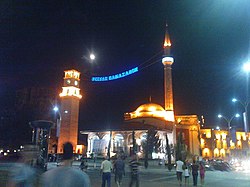Mahya lights
However, they were featured as early as 1578 in the German orientalist Salomon Schweigger's travelogue Eine newe Reyßbeschreibung auß Teutschland nach Constantinopel und Jerusalem.
In 1920, when festivities were toned down during the Armistice period and the Occupation of Istanbul, the Turkish novelist Yakup Kadri Karaosmanoğlu wrote nostalgically in the newspaper İkdam for the return of the mahya lights:[2] “We are filled with innocent and sweet memories of Ramadan.
Some of us miss the previous iftar tables, some of us the mahyas, some of us the exhibitions in Beyazıt, these fragrant buns, these hot pitas, in short, we are all longing for something.”The lights also made an impression on foreign visitors, such as the poet Théophile Gautier, who was in Istanbul for Ramadan 1854:[3] “The view from the Tepebaşı promenade was magnificent.
At the New Mosque, Süleymaniye, and all the temples of Allah from Sarayburnu to Eyüp, mahyas were shining brightly and proclaiming the formulas of Islam with fiery sentences.”Other visitors described the lights in equally glowing terms, saying "The Turks have succeeded in bringing down the stars from the sky and using them to write between the minarets.
[5] The lights are often arranged to form Islamic words of devotion (La ilahe illallah - "There is no god but God"), well-wishes on the arrival of Ramadan (Hoş geldin, on bir ayın Sultanı - "Welcome, Sultan of Eleven Months"), or short sayings promoting charity, peace, and goodwill (İnfak et mutlu ol - "Give and be happy"; Müminler kardeştir - "All Muslims are brethren"; Sevelim sevilelim - "Let us love, let us be loved").
Motifs such as roses, daffodils, the Maiden's Tower, boats, ferries, pavilions, fountains, bridges, mosques, trams, and even gun carriages have been displayed.




